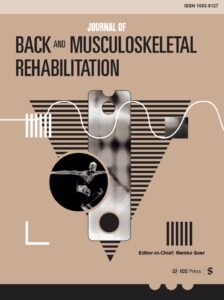Publications

Correlation between pressure pain threshold and L4-5 supraspinous ligament biomechanics after cesarean delivery under spinal anesthesia
Authors: Mohamed G. Ali 1, Rehab S. Mamoon 1, Reem M. Alwhaibi 2, Mohammed A.M. Sarhan 3, Amel M. Yousef 4, Fahima M. Okeel 4, Hoda M. Zakaria 5, Abeer A. Mohammed 5, 6, Mohammed A. Soliman 7, Mohammad Auais 8
Affiliations:
- Department of Physical Therapy for Women’s Health, Faculty of Physical Therapy, South Valley University, Qena, Egypt
- Department of Rehabilitation Sciences, College of Health and Rehabilitation Sciences, Princess Nourah Bint Abdulrahman University, Riyadh, Saudi Arabia
- Department of Physical Therapy for Musculoskeletal Disorders, Faculty of Physical Therapy, Suez Canal University, Ismailia, Egypt
- Department of Physical Therapy for Women’s Health, Faculty of Physical Therapy, Cairo University, Giza, Egypt
- Department of Physical Therapy for Neurology, Faculty of Physical Therapy, Cairo University, Giza, Egypt
- Department of Physical Therapy, Faculty of Allied Medical Sciences, Isra University, Amman, Jordan
- Department of Medical Anesthesiology, Faculty of Medicine, South Valley University, Qena, Egypt
- Department of Physical Therapy, School of Rehabilitation Therapy, Queen’s Health Sciences, Queen’s University, Kingston, Ontario, Canada
Journal: Journal of Back and Musculoskeletal Rehabilitation - March 2025 (DOI: 10.1177/10538127251318943)
-
Field & Applications:
- Medical
- Women's health
- Low back pain
Background: Localized low back pain is a frequent complaint after spinal anesthesia for cesarean delivery (CD).
Objectives: This study aimed to examine the pressure pain threshold (PPT) and biomechanical properties (stiffness, elasticity, relaxation time, and creep) of the L4-5 supraspinous ligament at the spinal anesthesia needle insertion site in women who had CD. These measurements were compared with those from the controls who never had pregnancy or anesthesia, and correlations between the variables were explored.
Methods: A retrospective cohort study involved 44 women, divided into two groups. Group A: 22 women experienced spinal anesthesia for CD, and Group B: 22 women represented the controls. L4-5 supraspinous ligament’s PPT was measured using pressure algometry, and its biomechanical properties were assessed with the MyotonPRO device.
Results: Significant differences were found in PPT between the two groups (P = 0.0001), but non-significant differences were observed in stiffness, elasticity, relaxation time, or creep (P = 0.318, 0.344, 0.241, and 0.227, respectively). There were also non-significant correlations between PPT and biomechanical properties.
Conclusion: Women who experienced spinal anesthesia for CD showed increased tenderness and lower PPT at the L4-5 site, 6–12 weeks postpartum, with minor changes in supraspinous ligament biomechanics. The relationship between PPT and these properties was negligible.
Keywords: biomechanics, cesarean delivery, MyotonPRO device, pressure algometry, pressure pain threshold, spinal anesthesia, supraspinous ligament
Women who underwent midline spinal anesthesia for CD experienced tenderness and a notable decrease in the supraspinous ligament pressure pain threshold (SLPPT) at the L4-5 level, where the needle was inserted, at 6–12 weeks postpartum. This decrease in L4-5 SLPPT indicates an increased perception of localized low back pain. The biomechanical properties of the L4-5 supraspinous ligament showed only minor changes between the two groups. There was a negligible association between L4-5 SLPPT and all biomechanical properties of the L4-5 supraspinous ligament in the two groups. Also, these biomechanical properties collectively do not predict a significant portion of the variability in L4-5 SLPPT. Clinically, this study highlights the need for women’s health physical therapists to develop postpartum pain management strategies focusing on localized spinal sensitivity rather than structural L4-5 Supraspinous ligament changes.


